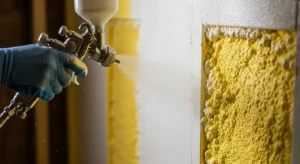Selecting the right insulation for your home is very important in ensuring energy conservation, comfort, and cost-effectiveness. The most frequently chosen types of insulation include spray foam insulation and traditional insulation like fiberglass and cellulose. Each of the two types has its advantages and disadvantages. When it comes to home insulation, two popular options are spray foam insulation and traditional insulation, but which is best for your home?
What is Spray Foam Insulation?
It is a closed-cell material that is sprayed in liquid form, and the material expands immediately after spraying to fill the gaps and cracks as well as seal the walls, roofs, and other surfaces. There are two basic types of spray foam: open-cell foam and closed-cell foam. The open-cell foam is lighter and is used as a sound insulator and for insulation of interior spaces. Closed-cell foam is denser and stiffer and provides better insulation and waterproofing than open-cell foam.
What is Traditional Insulation?
Traditional insulation can be defined as the commonly used insulation materials, such as fiberglass, cellulose, and mineral wool. Fiberglass insulation, made of fine glass fibers, is typically found in batts or rolls. Cellulose insulation is made from recycled paper products treated for fire resistance and is usually installed by being blown in.
Comparing Insulation Types
Thermal Performance
The main job of insulation is to keep your home warm in the winter and cool in the summer by reducing heat transfer. Spray foam insulation is great at this because it has a high R-value, which means it resists heat flow very well. Closed-cell spray foam, in particular, has one of the highest R-values per inch, making it very effective at insulating and reducing energy loss.
Traditional insulation materials like fiberglass and cellulose also help with thermal performance, but they generally have lower R-values than spray foam. They can still work well if they are installed correctly and are thick enough.
Air Sealing
Spray foam insulation is excellent at sealing air leaks. When sprayed, the foam expands to fill every gap and crack, stopping drafts and making your home more energy-efficient by reducing the load from your heating and cooling systems.
Traditional insulation, like fiberglass and cellulose, doesn’t seal air as well. They can leave gaps that allow air to pass through, which can lead to energy loss. When using traditional insulation, you might need extra sealing measures, like caulking and weatherstripping.
Moisture Resistance
Controlling moisture is another important factor. Closed-cell spray foam is highly resistant to moisture, making it a good choice for damp areas or places prone to water exposure. It acts as a vapor barrier, preventing water from getting in and stopping mold and mildew growth.
Traditional insulation materials vary in moisture resistance. Fiberglass can lose its insulating power when wet, and cellulose can absorb moisture even though it is treated for fire resistance. Mineral wool is more resistant to moisture but still doesn’t match closed-cell spray foam in preventing water damage.
Installation and Longevity
Spray foam insulation needs to be installed by professionals because of the special equipment and skills required. It costs more initially, but its long life and performance can make up for the higher upfront cost over time. Spray foam can last as long as your home without needing replacement.
Traditional insulation materials like fiberglass and cellulose are generally easier and cheaper to install. They can be good for DIY projects or those on a budget. However, traditional insulation can settle or degrade over time, which might mean you’ll need to replace or add more insulation layers eventually.
Environmental Impact
Spray foam insulation, especially the closed-cell kind, often contains chemical compounds that can raise environmental concerns. However, newer formulas are more eco-friendly and have a reduced impact on the environment.
Traditional insulation materials like cellulose are often praised for being environmentally friendly. Cellulose, for example, is made from recycled paper, making it a sustainable choice. Fiberglass also has some recyclable content but is not as eco-friendly as cellulose.
Also Read: Benefits of Spray Foam Insulation in New Construction
Which is Right for You?
Choosing between spray foam insulation and traditional insulation depends on your needs, budget, and priorities. Here are some simple tips to help you decide:
- Energy Efficiency: Spray foam is better if you want maximum energy efficiency and an airtight seal.
- Moisture Control: Closed-cell spray foam is best for areas with moisture or where you need a vapor barrier.
- Budget: Traditional insulation is cheaper upfront and good for those on a budget.
- DIY vs. Professional Installation: Traditional insulation can be a DIY project; spray foam needs professional installation.
- Environmental Concerns: If being eco-friendly is important, cellulose insulation is a great option.
Looking for a Professional Spray Foam Installation Service Provider?
Both spray foam insulation and traditional insulation have their pros and cons. To make the best choice, think about your home’s needs and talk to insulation professionals. No matter which type you pick, properly installed insulation will make your home more comfortable, energy-efficient, and valuable.
At Air Seal Insulation Systems, we provide top-quality spray foam insulation. Our expert team ensures precise installation for superior energy efficiency, moisture control, and long-lasting durability.
Contact us for reliable service and outstanding results to keep your home comfortable and efficient.




